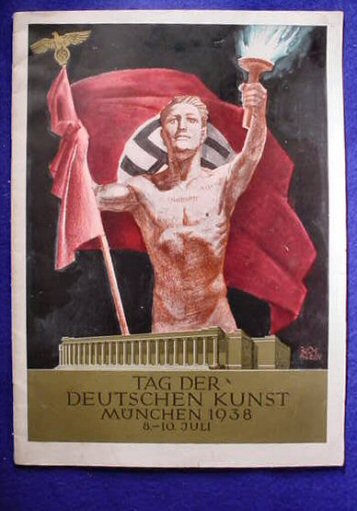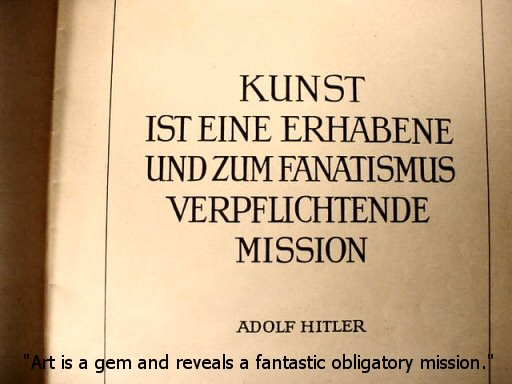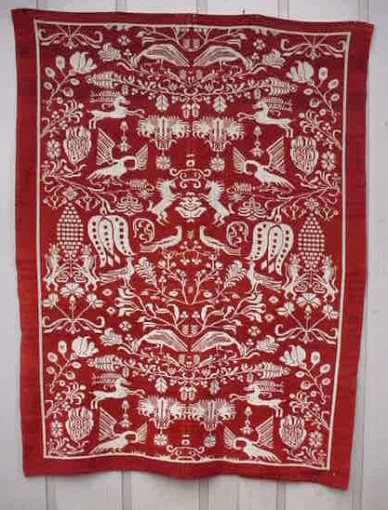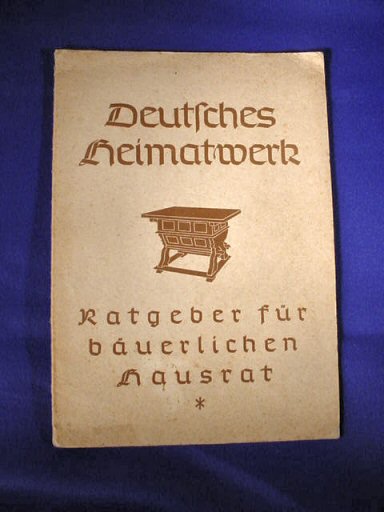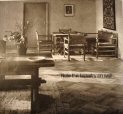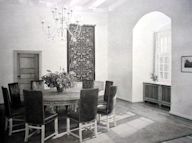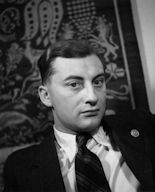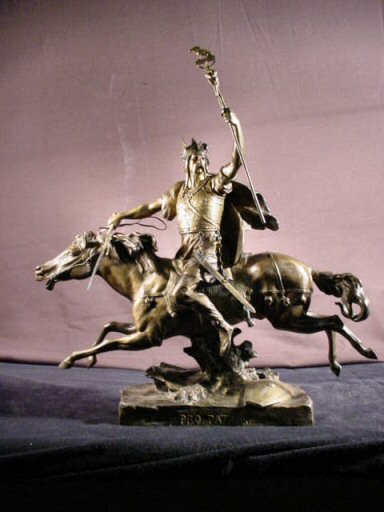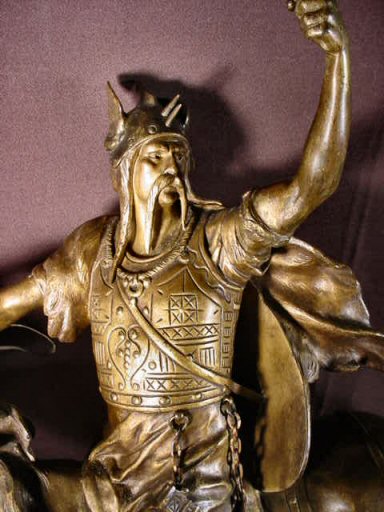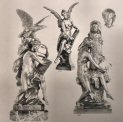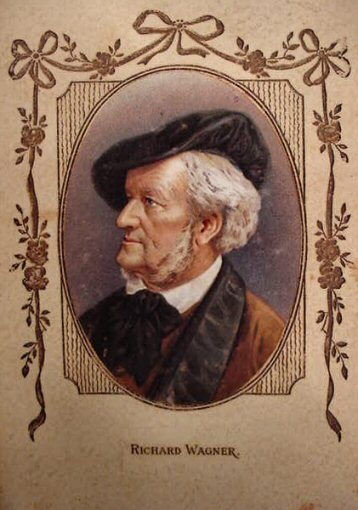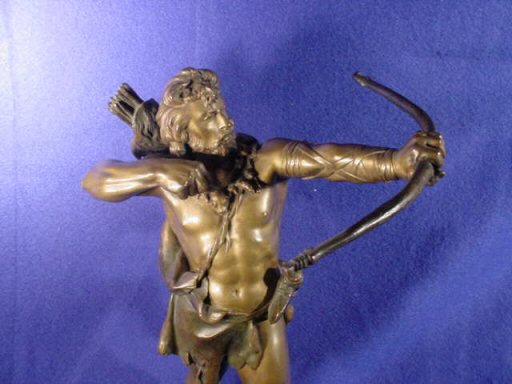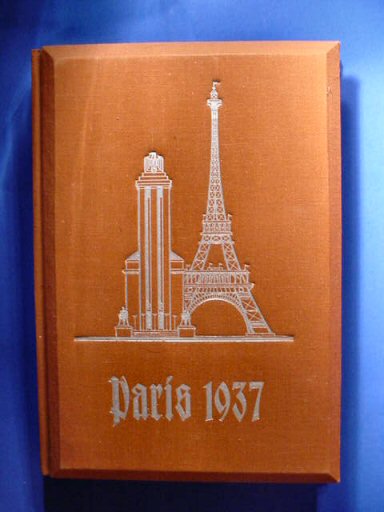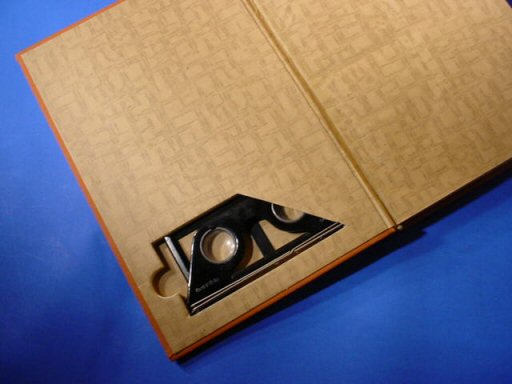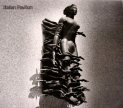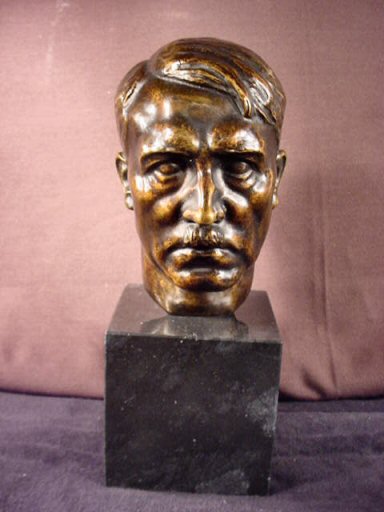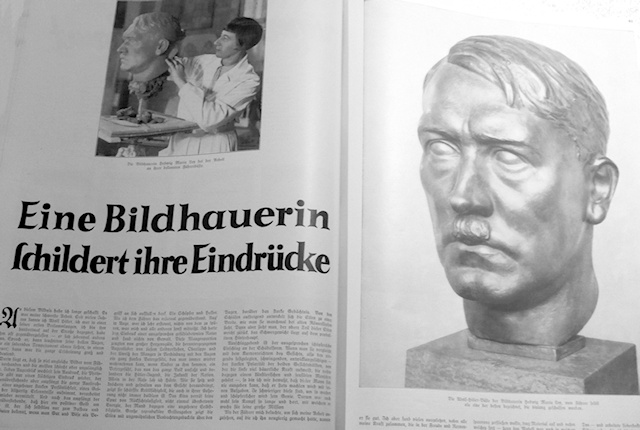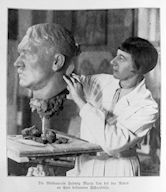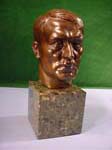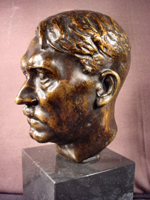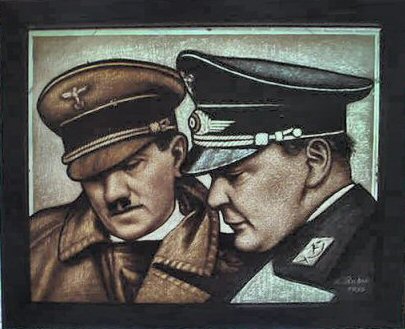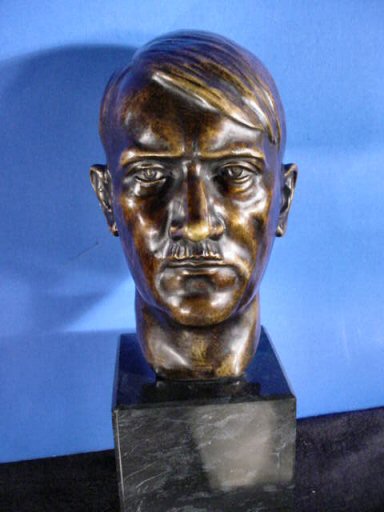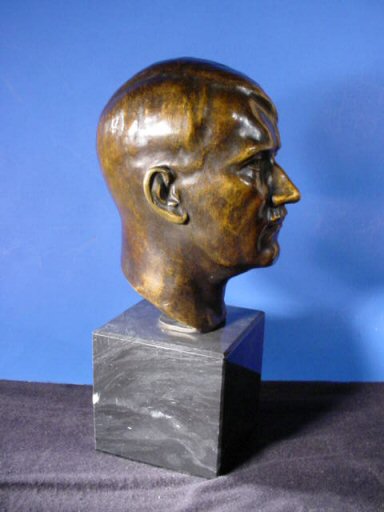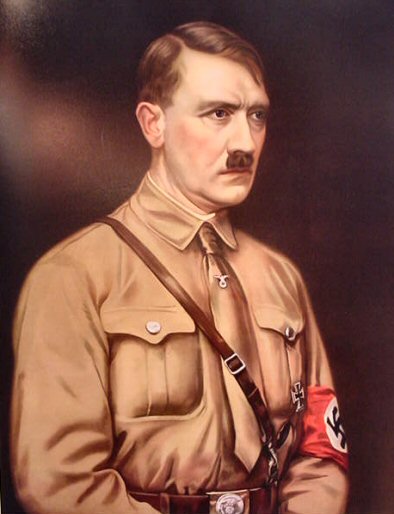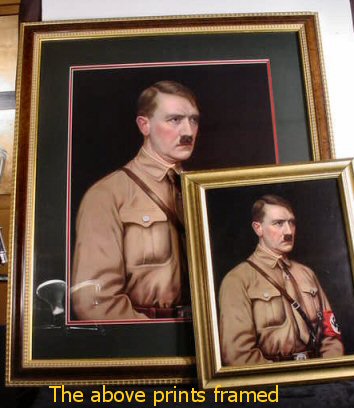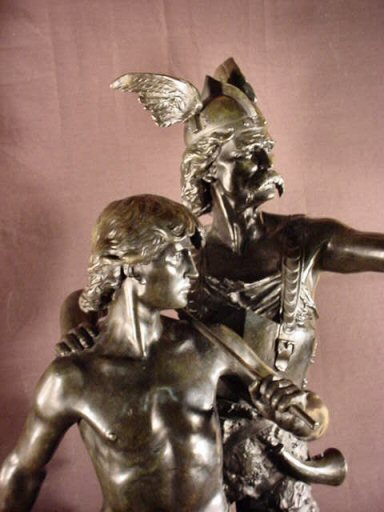|
|
|
|
Third Reich Art
Page 13
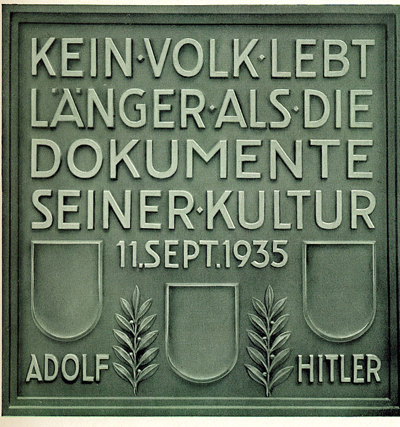
"No people live longer than the documentation of their culture."
|
|||||||
|
Book Tag der Deutschen Kunst München 1938, 8.-10. Juli (Item ART 13-1) |
|||||||
| DESCRIPTION: Day of German Art Munich is a 24-page booklet that commemorates the day of German art in Der Haupstadt der Bewegung, head city of the movement. This was the “fest” in the year 1938 that celebrated the one-year anniversary of the opening of the Haus der Deutschen Kunst (The House of German Art). Inside are a few of the architectural art pieces throughout Munich and pictures from the 2,000 Years of German Culture parade that was held in 1937 to commemorate the completion and opening of the art gallery, and if you like dramatic realistic art this was the absolute greatest collection the world had ever seen. No degenerate Picasso’s here! The book measures 8 1/2 x 12 inches and the greatest feature is the cover. Here was culture pride in earnest with the great picture by Prof. Richard Klein, one of Germany’s most dramatic artists.
PRICE: SOLD |
|
||||||||||||||||||||||||||||||||
|
NS Volkskunst Wandteppich, National Socialist-inspired Tapestry (Item ART 13-2; AHN 3-8) |
||||||||||||||||||||||||||||||||
| DESCRIPTION: The NS Kunst Bewegung, or art movement, was from its inception looking for a new art form with the spirit of the ancient values and traditions. One of the artistic phenomena that evolved was “ Volkskunst,” or folk art, and it derived from the classic and beautiful art expressions of the early Germanium, especially the Teutons and the ancient Saxons. The tapestry that we offer here is the typical wall hanging as promoted by the NS Bauerlichenhausen, or farmer’s house. Farming and other agricultural pursuits were encouraged and rewarded in the Third Reich. There was a vast back-to-the-land program sponsored by SS-Obersturmführer Walter Darré. Included in this program was schooling in the Bauerenkunst, or typical ancient art as expressed in the farm communities of the old Reich. Of course the Deutsches Ahnenerbe or Office of Ancestral Heritage had a hand in this, as well. It sponsored with Darré an inner-party program and educational foundation known as the Deutsches Heimatwerk. This was an academic study group that researched and taught the arts of this particular nature, but its main input was the promotion of the resurgence of Volkskunst to modern-day beautification and application to the home of citizen farmers. Students were taught to create such items as pottery, ironwork, wood carvings, and woven items such as, and most importantly, tapestries. The tapestry was considered almost a sacred thing to the ancients and to the NS mythos. The Norms of Germanic saga weaved the destiny of man while seated under the Heilegebaum, the oak tree, the holy tree of Germanic culture. We include pictures from the special publication Deutsches Heimatwerk, the official Bauerlichen guidebook. In this book are plans, photos, descriptions that demonstrate the style of the approved Bauerinmobile, farm furniture, and trappings for the NS farmstead. In these pictures you will see a tapestry much like the one we offer hanging on the wall of an approved “Gutezimmer” (excellently laid out room). You will also see that this artistic expression with the mythological animals appears also on chair upholstery. IN an article from another NS magazine for women called Saxon Volkskunst, you can see a couple of embroideries employing again these flora and animal scenes so prevalent in this exclusive NS art form and in the Ahnenerbe publication by Siegfried Lehman, Deutsche Volkskunst. More of such items are shown with this theme. You can also go to our Ahnenerbe chest to be seen at Item AHN 3-5 and compare some of the woodwork as shown in this book published in 1943 by the Ahnenerbe Stiftung Verlag Berlin-Dahlem. The importance of tapestries cannot be underestimated in the NS Reich and this is a very important one. In the Reich’s Chancery there were several that were almost identical in design to this one. The size of this amazing art piece is 53 inches by 6 feet! The tapestry was done in two parts and expertly joined in the middle as many of the important ones were accomplished. The condition is excellent and the colors are brilliant. The pattern is really beautiful and it speaks volumes about the NS artistic expression as hardly anything else could. We are very proud to present this great historical item to the collecting and museum world.
PRICE: SOLD |
| ||||||||||||||||||||||||||
|
Magnificent Bronze Statue of Germanic Warrior in Victory Passion (Item KSTATUE 3-10; ART 13-3; OLD 5-6) |
||||||||||||||||||||||||||
| DESCRIPTION: In his hand held high is the captured standard of the First Legione Italica, the elite army of Rome. This legion had its permanent bases in Lugdunum, Gaul (Lyon, France) and in 11. 69 5th century AD at Novae (near Svistov, Bulgaria). In the 190s AD this army group built the fortifications along the Danube. The illustrious 10th Legion also used the boar for it emblem; mostly as an insult to the Hebrews in the cities of the Roman occupation; its being a direct affront to the custom and religion of Israelites. Throughout Roman military history there were a thousand conflicts with the Germanic tribes and the legions of the Roman emperors. The most important of these being the battle of the Teutoburgerwald when Publius Quinctilius Varus marched forward with three Roman legions to cross the Rhine to conquer the Germanic lands. He was met by Germanic tribesmen led by the warrior Arminius, (or Hermann, in German) the leader of Cherusci. Three Roman legions were totally wiped out. The outcome of the battle established the river Rhine as the boundary of the Roman Empire for the next few hundred years until the decline of the Roman influence in the west. The Roman Empire was never able to conquer GERMANIA, although many attempts were made. The tribes that Hermann was able to assemble for the fight were finally allied after centuries of warfare against each other. They were the Cherusci, Marsi, Chatti, and Bructen. They saw with Hermann’s convincing that they needed to come together finally to oppose a great, dangerous enemy. Varus never expected to be met with a now-united army of Germans. To see more about this, the most important battle ever fought from the German concept, go the Google and search Teutoburger Forest Battle and our site at Items OLD 4-7 and 4-8 and Item OLD 3-2. This magnificent bronze sculpture dramatically depicts a Germanic warrior in full regalia on horseback. He holds aloft the captured standard of either the first or 10th legion that has been defeated (note the boar symbol). On the ground below the galloping hoofs are the shield of the legionnaires and another fallen standard of another legion defeated at whatever battle this might represent. The warrior is clothed in the typical garb of the Teutonic tribes with the winged helmet so popular among the Cherusci and the Goths. The sword in his right hand is the very typical one used by the Germanic hordes. The bronze is by a French artist: These Teutonic or Gaulic statues usually are. It’s signed by E. Picault and has a stamping in a circle that says “Vrai Bronze.” Emile Louis Picault worked from 1860-1915. He had a 50-year career. He worked tirelessly producing approximately 1,000 exciting sculptures. His choice of subject was predominantly heroic men of action. Many extraordinary plaques and medallions have survived, while only a handful of busts exists. Among his repeated themes were memorial monuments, famous personages, blacksmiths, warriors, knights, and musicians. These were often accompanied by inspiring inscriptions drawn from the Latin language. He is recognized as one of the greatest bronze sculptors of Europe in the 19th century. This bronze of the victorious Teutonic warrior is a classic example of his magnificent work. We show a few of his other sculptures from the four-volume set Bronzes, Sculptors, Founders 1800-193 by Harold Berman. In this bronze both man and horse are in the finest detail. It is most dramatic indeed. The accuracy of the equipment is phenomenal: the sword, the shield, the helmet, the scabbard are just historically correct in every way. The horse is especially great. The sun symbols on the horse blanket and the man’s vest indicate sun-worshipping tribal faith. The base contains the words in Latin Pro Patria that translates to “For Fatherland.” This is appropriate because of the subject portrayed. This is an exciting sculpture in wonderful condition. It’s historically important and a great collector’s item for a faithful Germanophile.
PRICE: SOLD |
| |||||||||||||||
|
Hand-painted Art Spoon of Richard Wagner (Item ART 13-4; WAG 1-1) |
|||||||||||||||
| DESCRIPTION: Here is an absolute gem of Wagnerian theme art the world’s greatest composer (our opinion) is depicted in lifelike realism. This art spoon is entirely hand painted by someone back in the 1800s, who was a master miniaturist of the first order. The immortal master composer of Bayreuth is shown with his ever-present beret upon his head. Wagner, 1813-1883, was not only a great musician, but a philosopher of note and an author of renown. See our description of another miniature portrait at Item OLD 4-3. The spoon is of a type sold at the Wagner homestead and museum in Bayreuth back in the days when an Andenken, or souvenir, was not a mere plastic insult to the memory of great men and great times. They were costly even in their time, but they were fine and beautiful and treasured today by connoisseurs of elegant and meaningful, historical relics of the grand era. The spoon measures about 5 1/4 inches. It’s crafted in ‘800’ silver and is so marked with the half moon and crown plus a maker’s logo. The harp shown at the top is typical of the Germanic symbol for classical music. Just below this is a white enameled section labeled “Bayreuth.” This is a true Germanic treasure.
PRICE: $495.00 |
|
||||||||||||||||
|
Bronze Sculpture of Teutonic Hunter (Item ART 13-5; HUNT 7-6; KSTATUE 3-11) |
||||||||||||||||
| DESCRIPTION: We have seen larger bronzes; we have seen bronzes by famous sculptors; we have seen bronzes that in themselves are famous; but, we have in all our years never seen a better bronze sculpture than this one. The artist who created this one was a master beyond comparison; an archeologist (at least in theory), and with a fantastic knowledge of human anatomy. Nothing touches this piece for sheer lifelike quality throughout. The statue is a depiction of an ancient Germanic warrior in the stance of hunting with bow and arrows. Every vein, every muscle tenses as he loosens the arrow at the game he hunts. He stands upon a rock formation that is also ultra-realistic. He wears animal-skin garments with an animal-skull necklace that adorns his chest. He has a sinew-wrapped stone-head ax at his waist. The quiver on his back and the bow are so realistic as to make the viewer sure that he has just seen the arrow in flight. The Aryan face and typical top-knot hairstyle is Teutonic in every way. These were the warriors that defeated three Roman legions at the Teutobergerwald battle under the leadership of Hermann, the Churisi, in the year 9 AD. We cannot say enough about this magnificent sculpture. It is in pure bronze with a great patina. It stands about 14 inches high and is signed by Henry Weisse. Note: it has always been said that when an artist can portray hands, “he has arrived.” Hands are more difficult in paintings and sculpture than a face. Even more difficult are feet. Look at the images of the feet to comprehend the excellence of Weisse’s work. We have included with the overall pictures a group of detailed images that should be studied closely. You are in my opinion looking at one of the finest bronzes to ever come out of the Deutsches fatherland. We don’t know when Mr. Weisse worked, but the piece was typical of the romantic bronzes of the mid 19th century. However, the theme of the noble Germanic warrior was foremost in the mythos of the NSDAP (Nazi Party) and it could be as late as that period. It is a true treasure and an important art masterpiece indeed. This is for the ultimate connoisseur of realism, he that would reject the garbage called “modern art” as so much Dreck and Kitsch.
PRICE: $9,850.00; should be much more |
|
|||||||||||||||||||||||||||||||||
|
3-D Book on the Paris Exposition of 1937 in English and German (Item ART 13-7; AHN 3-8) |
|||||||||||||||||||||||||||||||||
| DESCRIPTION: Here in excellent-plus-plus condition is the official Raumbilderbuch (3-D book) devoted to the wonderful international exposition held in Paris in 1937. These Raumbilders are extremely rare today when complete and this one is truly complete with all 100 pictures AND the text is in German, French, and English making it the only one of these 3-D books to have this feature. The National Socialist Germany pavilion at the exhibition was by far the best and most impressive with the gigantic tower designed by Albert Speer. It appeared massive and yet simple and elegant. This straight-lined architectural creation was dominated by a high, discreetly ornamented tower surmounted by the national eagle and swastika designed by Kurt Schmid Ehmens. Surrounding the entrance were two fantastic statuary groups by Josef Thorack. The impression produced by all of this superlative art and architecture was absolutely overwhelming. The rest of the description is laid out by the writer as he describes the interior with displays of all the artistic and technical advances in architecture, art, and industry that had developed since Hitler’s ascension to power in 1933. It was astounding! There were exhibits from all sections of German technology plus displays of items from all phases of the arts: Meissen and Berlin porcelains Leatherwork Solingen cutlery Cologne chasubles Musical instruments Fabrics of great beauty Merkins mechanical toys Publication and wood engraving Electrical instruments such as recording apparatus, broadcast transmitters Represented were Zeiss, Agfa, Bermpohl, Bentzin, Seimans a Mercedes-Benz racing car, which then held a world’s speed record An engine from the same works similar to those of the ill-fated airship Hindenburg and a model of a ship of the Kraft Durch Freude (Strength-Through-Joy organization). There was a wonderful sort of stage exhibit with a model of “The House of German Art” in Munich backed up with a large stained-glass window with the national eagle. The narrative goes on with many more descriptions of this amazing building that history records as the greatest of all exhibits ever featured at any such event (anywhere). The writer goes on to describe the other pavilions to include Egypt, Hungary, the U.S., Portugal, Spain, Poland, the Vatican, Uruguay, Norway, Greece, Italy, Argentina, and many others to include the URSS (Soviet Republic) which sat just opposite the German pavilion and was approximately the same size, but less high. The writer says “From a purely aesthetic point of view it is perhaps the most impressive all.” He adds, “The artistic sense of the Russians is of a quality that cannot be disputed, be they Bolshevists or not.” He highly praises the Italian pavilion and that of Canada. “The U.S. exhibit hall,” he says, “looks grand with the escutcheons of the different states on a high tower.” But at the point when the article was written it was closed to the public while the Americans were still arranging the interior exhibits. The writer goes on to describe many of the planned events and technological advancements noted in general. Here is a word about the Raumbild as we recognize it. This was an innovation in the art of photography that goes back into the 1860s, or earlier, whereby a picture is taken from slightly varying angles and fused together side by side to give the effect of a third dimension of depth when viewed with the aid of a pair of special magnifying lenses (stereoscope). Early models of the lens holders were quite cumbersome, but by the 1930s the Germans at last had developed a simple yet effective system where the glasses had been reduced to a manageable size, easy to use, and the photographic process had vastly improved the quality of the images, especially in the era of the Third Reich. In the front of the book is a compartment where the viewing glasses are stored. When removed and the cards are inserted in the framing you then find a good source that shines on the picture and “eureka!,” you are transported through time and feel you are standing before history. No normal flat picture can compare. Here is dimension personified. We can’t say enough abut it. It’s astounding! PRICE: $1,500.00 |
|
||||||||
Hitler Bust by M. Ley (Item ART 13-9; AH 20-1; BRONZE 2-2) |
||||||||
| DESCRIPTION: This is one of the first bronze art pieces that we managed to purchase from stock that was maintained by a German company in Gleiwitz, on the outskirts of Berlin. The company name was “Bergwerks V. Hutten A6.” Go to Item ART 9-1 to see a narrative of how these fine sculptures were acquired. Hedwig Maria Ley was a woman sculptress, well known and accomplished in the period of the Third Reich. She enjoyed the sponsorship of Adolf Hilter himself after he saw a fine impression of Dietrich Eckhart, Hitler's friend and mentor. Her particular style is notable. The Hitler bust was said in party circles to be the best likeness of the Führer ever produced, even though Hitler favored the bust of himself by Ferdinand Lieberman. We know of this lady’s art and we realize she was among the best. In our extensive library we once had a picture of her sculpting the “Führerbuste.” If anyone has a good image and/or a biography of Frau Ley, we would appreciate it if they would help us out and educate us a bit further. The original bust we sold was in beautiful condition with only the plinth (base) replaced. Please read the narrative of how the Nuremberg eagles and standing Hitler statue were obtained. This bust measures 11 inches on the base. The bronze head by itself is about 7 inches high with a width ear to ear of 4 inches. The one we can procure today for you would be a perfect re-creation of the Maria Ley Hitler bust done in exactly the same manner as the original that we sold some time back. It would sell for the same price as the original and is 100 percent the quality.
PRICE: SOLD |
|
|||||
|
Fensterglas depicting Adolf Hitler and Hermann Göring (Item ART 13-10; AH 20-2; GOR 8-9) |
|||||
| DESCRIPTION: Here is a very rare Fensterglas, or window hanging, in hand-painted glass. This is done with a process of painting on top of the glass and reverse, as well (a true German art form). This depicts the Führer and the Reichsmarschal as they go over battle maps and plans together. It is beautifully done and measures 11 x 9 inches in its oak frame. The glass itself is 9 3/4 x 7 3/4 inches and is in wonderful condition and a real art rarity.
PRICE: WITHDRAWN |
|
|||||||||||||||
|
Bust in Bronze of Adolf Hitler (Item ART 13-11; AH 20-4) |
|||||||||||||||
| DESCRIPTION: Pictured here is a very fine bust in genuine bronze of the German chancellor. This was one of the pieces recently discovered and virtually uncovered in the town of Gleiwitz, Poland, a community near the Polish border. The Kunstglass Company was famous throughout the Third Reich for being the foundry where most of the art bronzes of the Third Reich were produced. Please look at Item ART 9-1, the Bronze Nuremberg Eagles. You can read the story of how we found some of these wonderful bronzes. The company, Preussische Bergwerks v. Hutten, also produced the fine Hitler bust at Item ART 13-9. We were most fortunate to have the chance to purchase these treasured pieces. Note: If you will look at the plinth of this pictured bust you will see a white veinlike line. This is not damage; it’s the natural marbling in the granite. Also note that each plinth is different and we did have more than one of these busts. It you read the information Item ART 9-1, you will see that we had to have the plinths (bases) produced and mounted at another firm in Gleiwitz because the Bergwerk was a foundry and did not produce the base, but we managed to find the exact quarry people who had applied the bases for the bronzes of Hutten A.G. in the time of the Third Reich. It’s most important to note that some these were original bronze sculptures and only the bases are applied recently, but further note that the marble and granite are of the exact type as originally used by the same company that supplied them in the 1930s and 1940s. You will never find a finer original Hitler bust than these shown here and the one sculpted by the female artist, Ley, at Item ART 13-9, and the price is only a tenth of what other sites ask when they would have been fortunate enough to procure one. Hitler busts are rare and in this condition, spectacular! The busts were signed ‘Hans Martin,’ whom we understand was an accomplished artist in the city of Charlottenberg. Herr Martin certainly outdid himself with these masterful studies of Germany’s Führer. WE have shown in our accompanying images a few photographs of Hitler during several years of his life for your comparison. This is without a doubt one of the best of the “Führerbuste” ever offered. It measures about 12 inches tall. Unfortunatly, we sold the two originals we had some time ago and because we have so many requests for Hitler busts we have made arrangements to have a top-quality re-creation made of this bust that you can order and within a reasonable period of time we can procure one for you. The cost of making one of the re-created busts was practicaly equal to the price of the originals we had.
PRICE: SOLD |
|
|||||||||
|
Hitler Print in Full Color (Item ART 13-12; AH 20-5) |
|||||||||
| DESCRIPTION: Here is a great-looking print copied in special process from original that depicts in living color the young Hitler during the Kampfzeit (struggle for power). We recently found the original period print in Nuremberg, Germany, and we were struck by its natural depiction of Hitler in his early campaigning days—1920s and early 1930s. The likeness is phenomenal. This is so good that we will eventually have our artist in Germany do a copy for us and we will offer it in the section of our website at Art Executed by a German Master. Look in our listings under Third Reich. The future Führer is dressed in his ever-present brown shirt that became the standard of the movement. He wears the Sam Browne belt with brass buckle and cross strap. He wears the Iron Cross First Class that he was awarded for bravery while serving a courier in the WWI trench warfare. He also wears the swastika, NSDAP armband, and the eagle and swastika tiepin. The print can be ordered in two sizes: 16 x19 inches with a 2-inch-wide border, or 24 x 28 inches with 2 1/2-inch white border to the sides and 1 3/4 inch border at the top and bottom edges. We will sell them unframed, sent rolled in tube, ready for the frame of our choice. This is the very best Hitler picture we have encountered in many years. While our small supply lasts, the print process was very expensive!
PRICE: $68.00; for the smaller. $88.00; for the big one |
|
||||||||
|
More views of the Above Hitler Print (Item ART 13-12a; AH 20-5a) |
||||||||
| DESCRIPTION: We just can’t get over the realism, depth, and artist’s perception of these prints so we went out and had a couple framed and they look fantastic. This is probably the best picture ever produced of the German Führer before he was the Führer. The framed ones can be available, but are hard to ship; but it can be done. The large one is 36 x 30 1/2 inches in the frame. The actual print size is 19 x 24 1/2 inches. The beautiful frame looks like burled mahogany with gold-leaf edges. The small print is 16 x 20 inches in the frame; actual print size is 12 x 15 3/4 inches and is of wooden construction in gold tone. Both are superb.
PRICE: $225.00; for the large on; $175.00; for the small one |
|
||||||||||||||||||||||||||
|
Magnificent Bronze Sculpture of Teutonic Warriors (Item ART 13-13; KSTATUES 4-1; OLD 6-2) |
||||||||||||||||||||||||||
| DESCRIPTION: First of all, let’s emphasize the size of this sculpture: This is a huge piece. It measures 36 inches from the bottom of the base to the top of the warrior’s winged helmet. The base is 14 x 12 inches and is about 4 inches deep. It takes two good, strong men to lift it. The masterful artwork is by Emile LaPort (1858-1907). The name of this sculpture is “Pro Patria.” The foundry mark is Siot Decauville Fondeur Paris. Emile LaPort was a genre/landscape painter and sculptor of renown, who exhibited at Salon from 1881 to 1906. He sculpted “Pro Patria”/Gauois (Teuton) with Son, identical to Bonnardi’s Teuton and Son minus the sword on the son’s hip. His works can be found in museums—Angers, Autun, and Tourcoing. “Pro Patria,” the name of the sculpture, can be interpreted as “For Fatherland.” Yes, the Teutons were patriotic and this father as depicted seems to be teaching his son the use of weapons and the ways of war. In the period when this sculpture was created the French seemed more inspired by the old Teutons and Gauls than the Germans were. Thus, many of the best of the statues in bronze of Germanic warriors were produced in France. This study is by far the greatest of all such inspiring studies. When one of these “Pro Patria” sculptures does rarely show up over the years, invariably it is missing the ax and spear that is carried by the young lad. About 5 years ago we encountered one at an antique show in Miami Beach, Florida. Not only were these mentioned appendages missing, but also the sword from the waist of the father figure was missing. This sculpture is complete with all weapons and is in marvelous condition. This is a highly dramatic depiction of life and high adventure among the so-called Barbarians of the Germanic forests and glades. This is a museum piece personified, yet a cultured Germanophile would be more than proud and fortunate to count this masterpiece in his collection. Action bronzes today are bringing huge prices at fine antique fairs. We are offering this the absolute greatest sculpture in this particular designated artistic expression at a very competitive price.
PRICE: SOLD |
Page Thirteen |
Please refer to item designator in parentheses in all correspondence.
Please E-mail for any additional information you may need.If you prefer, contact 'Germania' at PO Box 68, Lakemont, GA 30552
or call at 706.782.1668.
Please! do not call during the wee hours of the morning. The best time for calling us is between 9 and 11 am and between 9 and 11 pm eastern time.


